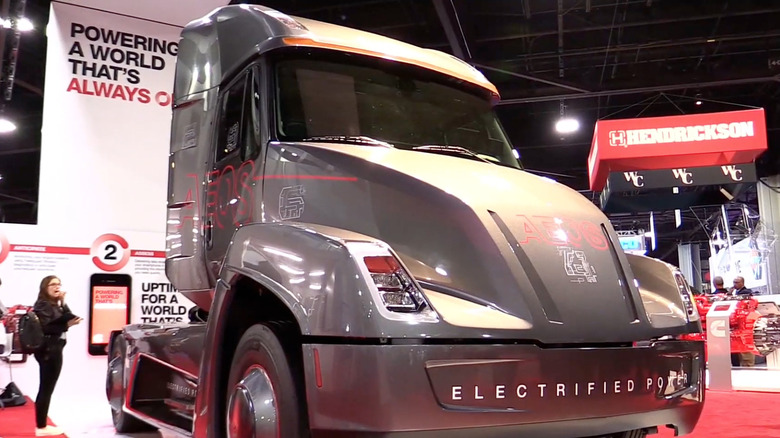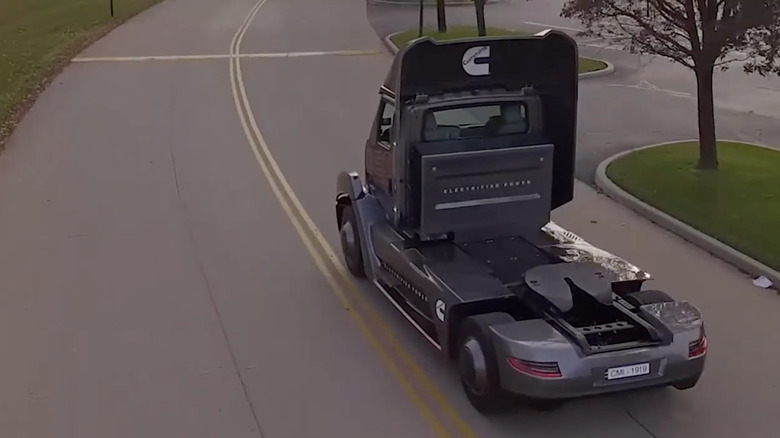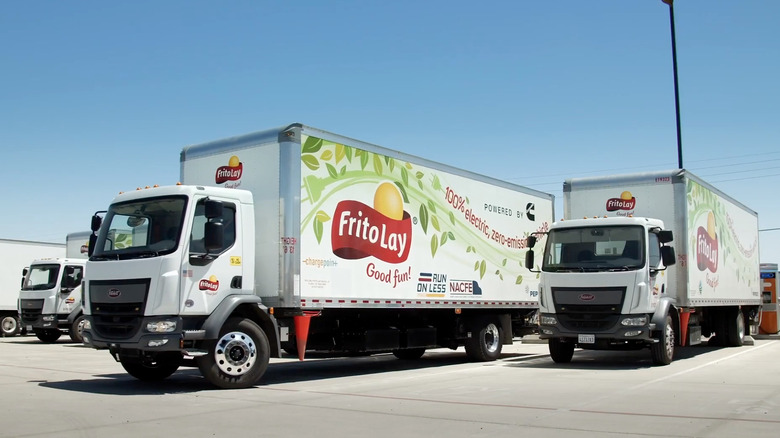What Happened To The Cummins AEOS Electric Truck?
In 2017, Cummins seemingly defied its status as a 100-year-old diesel powerhouse by revealing the AEOS, a fully electric Class 7 heavy-duty truck concept. Named after a mythological four-winged horse, AEOS was a surprising announcement in the electric vehicle (EV) space at the time — especially since it happened well before Tesla's electric semi-truck announcement.
Powered by a 140-kWh battery and capable of hauling 44,000 pounds, Cummins said AEOS would offer a 100-mile range and a charging time of just one hour. The goal was to launch the semi in 2019, then reduce the charge time to 20 minutes by 2020. Framed as an eco-friendly vehicle for urban deliveries and short-haul routes, the AEOS concept seemed like a great way for businesses to reduce their carbon footprint.
Even more ambitious was Cummins' plan for an extended-range version, which would utilize a small diesel engine to recharge the battery while on the move. This extended-range AEOS would have up to 300 miles of range and offer 50% fuel savings compared to diesel hybrids. Cummins made it clear that it didn't plan to build the trucks themselves and instead supply the integrated battery and drivetrain systems to Roush Industries. But the planned 2019 launch date came and went without any mention of AEOS. Despite all the initial hype, Cummins quietly shelved AEOS: It never began full-scale production, and Cummins didn't formally cancel it either.
Where did the Cummins AEOS go?
So, what happened? We can't know for certain until Cummins says so, but we can assume a combination of technical, infrastructural, and market realities likely played a role. For one, battery limitations were surely an enormous challenge. At just 100 miles of range, AEOS was restricted to short urban routes. While that might work for delivery trucks, it's not really scalable across the freight sector. Expanding the range by increasing battery size would probably mean cutting too deeply into payload capacity. For example, the company's estimates suggested it would take 19,000 pounds of battery to achieve a 600-mile range. That's nearly the entire weight of the AEOS cab itself.
Then there's the infrastructure issue. Charging a heavy-duty truck like AEOS wouldn't be as simple as plugging in a Tesla at home. It would require a high-capacity 140 kW station, and those were few and far between back in the late 2010s. Even by 2020, a 20-minute charging goal would still have been ambitious, if not improbable. Without a national network of high-speed chargers built for commercial EVs, AEOS faced the same problem plaguing most early electric trucks: Where would they recharge?
Market timing also has to be factored in. Cummins unveiled its electric truck before Tesla's long-delayed Semi, but its headline grab did very little to change the long-term EV market dynamics. Tesla's vision and vertical integration — building its own batteries and assembling complete vehicles — make it harder for others to scale up similarly.
Cummins shifted its focus on electric vehicles
Although AEOS quietly vanished, Cummins didn't abandon electrification altogether. Instead, the company has pivoted to more immediate and practical applications for its electric powertrains. For instance, in 2020, Cummins partnered with Frito-Lay to deliver a Class 6 electric box truck powered by its PowerDrive system. That vehicle ran daily food delivery routes in California with impressive reliability, covering about 65 to 80 miles per day and offering roughly 95% uptime. These real-world results proved electric trucks could work... just not for the long-haul or heavier-duty uses Cummins initially envisioned.
Diesel powertrains aren't going away anytime soon. About 75% of trucks on the road still use diesels, including more than 90% of long-haul rigs. Cummins itself still builds diesel engines in its factories worldwide. In that context, Cummins' dual-path approach — supporting clean diesel, natural gas, hybrid, and electric solutions — has positioned the brand in support of a slow, decades-long energy transition.
Cummins' global service network spans 190 countries, and the company's acquisition of drivetrain and electric powertrain company Meritor shows its continued investment in electrification. It's just chosen to move forward with real-world use cases and manageable technologies rather than betting big on concepts like AEOS that were ahead of their time in some ways — and just plain unworkable in others.


